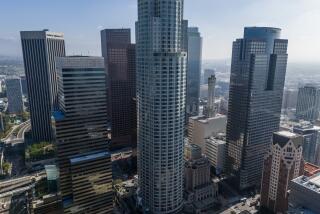Hollywood skyscrapers too close to earthquake fault, opponents say
- Share via
Los Angeles officials have asked the developer of a controversial Hollywood skyscraper project to conduct a new round of seismic tests to determine whether the project’s towers could be at risk in an earthquake. At the same time, state officials are carrying out their own geological study of the area to find out whether a known fault line near the building site is active.
The questions surrounding the project’s safety come at a critical time, with the City Council poised to take up a major vote on the proposal Wednesday. If the project is approved, New York-based Millennium Partners would be able to build more than 1 million square feet of apartment, office, hotel and retail space on about 4.5 acres of vacant parking lots surrounding the famed Capitol Records building.
The project’s developers say extensive testing has shown that the complex would not be built on an active fault. But critics of the project have seized upon the safety issue.
Until recently, criticism of the project had focused on its large scale — initial architectural renderings showed two soaring towers, one 55 stories and one 45 stories, before the project was downsized — as well as its potential impact on traffic. Earlier this year, the California Department of Transportation added its concerns, saying the city hadn’t factored in how the project would affect travel on the nearby 101 Freeway.
But in recent weeks, an attorney representing community groups that oppose the proposal has launched a campaign warning that the project site is dangerously close to what is known as the Hollywood fault.
At a news conference Monday, attorney Robert P. Silverstein accused Millennium Partners of using phony data to hide the building site’s proximity to the fault in geological reports it filed with the city. Philip Arons, a cofounder of Millennium Partners, said Monday that those allegations are false. In a statement, Arons accused Silverstein of “bluster.”
Silverstein also blamed engineers at the city’s Department of Building and Safety for not doing their diligence in evaluating the risk.
His complaints to the California Board for Professional Engineers, Land Surveyors and Geologists prompted the state licensing board to open an investigation into alleged misconduct by city engineers last month.
Luke Zamperini, a Department of Building and Safety spokesman, said he didn’t believe actions of the engineers in his department were unethical and suggested Silverstein’s complaint to the licensing board was strategic.
“When people are trying to stop a project, they will pull out any stops,” Zamperini said.
But he added that city engineers recently asked the developer to conduct further tests because of growing concern over earthquake safety.
The state weighed in on the matter on Saturday, when the chief of the California Geological Survey sent a letter to Council President Herb Wesson, notifying him that the Millennium site “may fall within an earthquake fault zone.”
In the letter, John Parrish said his agency launched a study of the Hollywood fault after several independent studies suggested it may be active. He said the study may not be completed until 2014, but noted that if the fault is found to be active, the city would be required by state law to withhold permits for new development projects until testing could prove that there is no risk.
Ed Johnson, a spokesman for Wesson, said the Council president plans to go ahead with Wednesday’s hearing despite the letter from Parrish. Last month, the Council’s Planning and Land Use Management committee signed off on the project after the developer agreed to lower the height of both towers, reducing one from 55 stories to 39 stories and the other from 45 to 35. Many neighbors who oppose the project say that’s still too tall.
A spokesman for Councilman Mitch O’Farrell, who represents much of Hollywood, said he has been meeting with stakeholders and will not comment on the project until it comes to the council on Wednesday. In the past, O’Farrell said that he supported new development around the Capitol Records building but believed the towers originally proposed by the developer were too tall.
Millennium Partners and its executives gave at least $11,400 to help get O’Farrell elected this year, according to city ethics records. The company gave $10,000 to an independent group supporting O’Farrell, who was locked in a contentious race with former Public Works Commissioner John Choi. Two of the firm’s partner’s contributed $700 each.
O’Farrell was not the only politician that benefited from the developer’s help this year. Millennium contributed $10,000 to a committee to help elect Mayor Eric Garcetti. It also gave $7,500 to a group supporting Garcetti’s opponent, then-city Controller Wendy Greuel, as well as $5,000 to a group supporting City Councilman Gil Cedillo.
Garcetti, who represented Hollywood on the Council for 12 years before becoming mayor earlier this month, also said he opposed the original height of the towers. Since the developer downsized the buildings last month, he has remained mum on whether he supports the current iteration of the project.
On Monday, Garcetti spokesman Yusef Robb noted that the developer had met Garcetti’s demands for shorter towers and said the mayor “will continue to monitor public, city department and other input.” Robb did not comment on the concerns over earthquake safety or the allegations that engineers in the Department of Building and Safety failed to properly evaluate the project’s risk.
A yes vote on Wednesday would give the developer permission to build on the site, although the developer would still need to secure building permits with the city before beginning construction.
More to Read
Sign up for Essential California
The most important California stories and recommendations in your inbox every morning.
You may occasionally receive promotional content from the Los Angeles Times.










